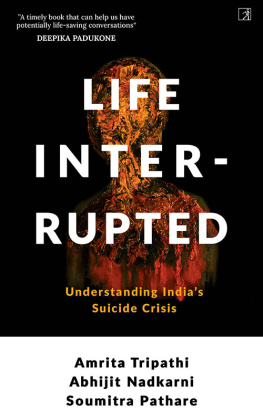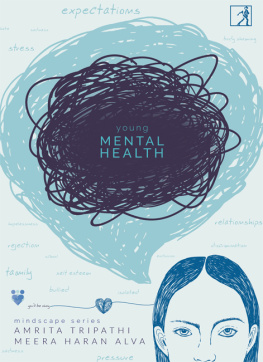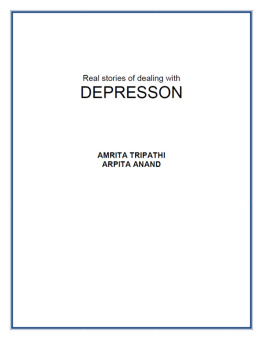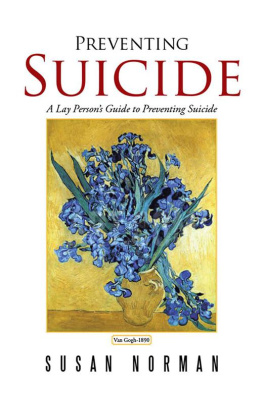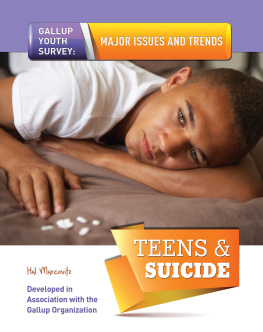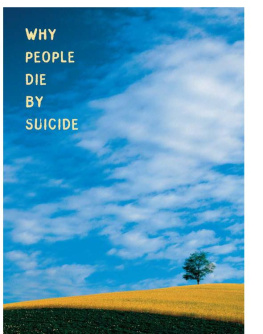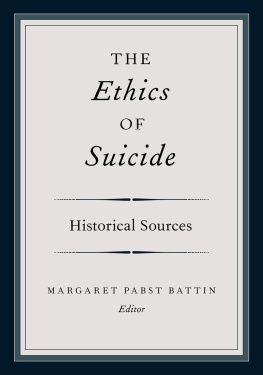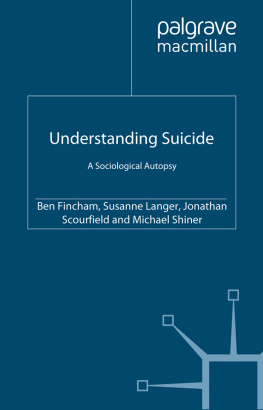
LIFE INTERRUPTED
LIFE
INTERRUPTED
UNDERSTANDING INDIAS SUICIDE CRISIS
AMRITA TRIPATHI
ABHIJIT NADKARNI
SOUMITRA PATHARE

INTRODUCTION
W hy do we need to talk about suicide and suicide prevention in India? The short answer is that it can be the first step to saving lives. India sees approximately 20% of the worlds suicideseven judging by the figures we get from the National Crime Records Bureau (NCRB), which are widely estimated to be much lower than the reality.
And yet, there is an overwhelming silence around the subject, broken only by often-cacophonous news reports when theres a tragedy around a celebrity, or daily mini-tragedies, where editors and reporters share gruesome details with no thought to the well-known guidelines for the media which have been formulated specifically to prevent copy-cat suicides. Theres hardly any recognition by organisations such as the WHO and the Samaritans in the mainstream media that suicide is preventable, that even the way we talk about, report and address these issues via different stakeholder groups can save lives. As a country, we may have become numb to the tragedy, forgetting that there are individuals and families, ripped apart with each statistic that is reported (and as youll read in the book, even those statistics seem to err on the side of under-estimates).
Our book will attempt to demystify the issue of suicide in India, while acknowledging that this is a complicated, multi-factorial and inter-sectoral issue. We will hear from suicide survivors and suicide loss survivorsthat is, families affected by suicidewho share heart-felt vulnerable moments from their own journeys. We will hear from senior editors, policy-makers, mental health experts and advocates, survivors, family members and more, as we draw on the available studies and research that all point to the fact that we can address this major issue, collectively. As youll read through the following chapters you will realise that, while there are clear best practices and recommendations, which we should be looking to implement, there are also macro-level policy changes required. We need to think of the individual the student, the farmer, the housewifebut also the collective, the social, the communityand address the social determinants which all too often play a role.
There is evidence-based science of suicide prevention that we will aim to make more accessible to a general audience. But were talking to you as specialists too as editors and reporters, policy-makers, teachers and counsellors, family members, this affects each one of us.
Our book is not intended to be prescriptive or even an encyclopedia on everything to do with suicide prevention. This is not an academic book, and while we draw on leading and latest sources and evidence, we are also deliberately eschewing jargon for a more conversational, accessible tone of voice. A note on the structureyou will read chapters in the first person, as well as chapters that rely on intensive interviews done with subject matter experts.
Events and panels on suicide prevention can take place every year, with the laudable goal of normalising these conversations, and they are often eye-opening. For example, when we asked audiences how many had not been affected by suicide at a 2019 event in Delhi, we found only a couple of hands raised in a crowd of more than 50 people.
The point is we will talk to you about real people and share real stories and real advice. We have split up the book by stakeholder in a way, and also wanted to provide as much information as possible for those of you, our readers, who may be distressed or may know someone who is distressedwe are following best practices, like referring you to a list of functional third-party helplines in India, which we have shared right at the beginning of this book.
This is by no means meant to be a depressing book more a clear-eyed look at a very disturbing phenomenon, with practical next steps, as a call to action.
And one more note: We arent immune to this. Of the three co-authors, all have had some personal connection to the issue, whether it is through one of our colleagues dying by suicide, or suicide attempts in the family; one of us has spoken about suicidal ideation and a phase in their life when everything seemed so bleak that suicide felt like a viable option, though this was adamantly not the casetheir clear advice is that you speak to someone about what is bothering you.
(Note: if you feel distressed, please stop reading at any point, and reach out for professional help)
There are many issues when it comes to a complicated, inter-sectoral issue like this, but a few things to keep in mind at the outsetthere are major gaps when it comes to data collection and one major misconception is that suicide is only due to mental illness, which is emphatically not the case in India. The most dangerous issue is that the issue seems so complicated, that an almost-fatalistic attitude creeps in.
As we discuss some of these, through case studies and best practices, while addressing and busting common myths with multiple stakeholders, we hope that you will join us in this mission by becoming more informed, and sharing more from your own domain expertise and personal experience. The issue is critical, the science is being made more accessible every day, and the change could not come a day too soon. Lets not forget that behind each statistic is a real person, a real life, a real family.
INDIA HELPLINES*
- Aasra | 91-9820466726 | 24x7
- Government Helpline KIRAN | 1800-5990019 | 24x7
- Psycho-social Helpline run by iCALL | 9152987821 | Mon - Sat, 10 am to 8 pm
- SNEHA Crisis Helpline | HYPERLINK tel:+91983305268498330 52684 / HYPERLINK tel:+91916753576591675 35765 | Mon - Sat, 10 am to 6 pm
Connecting NGO | 9922004305 / 9922001122 | Daily, 10 am to 8 pm
(*Note that these are third-party helplines)
CHAPTER ONE
UNDERSTANDING SUICIDE
Who Is Dying of Suicide (and Why)?
I n 2019, K. Sujatha Rao, the former health secretary of India, caused a minor Twitter storm with her cryptic tweet saying 1 needs 2 be alive 2 be a patriot (sic). She was referring to our political and policy priorities, which focus on issues of terrorism while neglecting the bigger killerscommunicable and non-communicable diseases. When one moves the lens on to mental health to have a closer look it is clearly evident that this policy level neglect is further magnified. We got a peek into this neglect at the highest levels of government through the eyes of Ms Rao when she reminisced about her stint in the Ministry of Health and Family Welfare, Government of India. Ive worked in the Ministry of Health from 1988 onwards; from 1988 to 1993, I was director and Joint Secretary; and then from 1998 to 2003, and again from 2005 to 2010 I was Joint Secretary. In all those years, I had never heard of mental health, it was really not at all a priority or a concern for the Ministry of Health. Every Monday, we would have a meeting with the Secretary of Health and thats where the priority and high priority issues would be discussed. So, that I think would reflect on what really is a priority for the government at that time, and mental health was never mentioned. And so I really had no idea about mental health, I cant even recall which Joint Secretary dealt with it. Mental health really struck me as one of the most important areas that Ministry of Health should have been long engaged in.
Next page
